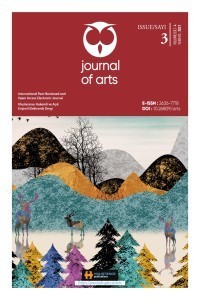ROLE OF PRINTMAKING IN MEXICAN REVOLUTION
At the beginning of the 20th century, Mexican Art was in close contact with the political processes in the country. The emergence of different focuses in the struggle for power and the political process exhibited a very dynamic structure politicized not only the Mexican people but also the Mexican art. It has been shown in the study that the repression in the political productions of the artists existed in a privileged structure before and after the Mexican Revolution. Printmaking, which became a political artistic production tool without detaching from the artistic context in the process, constitutes the important productions of Mexican Art during this period. As emphasized in the study, the printmaking productions of artists that relate to social structure, reflect their ideological perspectives and reflect their reflexes to daily and political events are therefore an integral part of the Mexican Revolution. These productions, which have survived until today, are among the most important parts of the most productive period of Mexican Art.
Anahtar Kelimeler:
Printmaking, Mexican Revolution, TGP, El Machete, LEAR
ROLE OF PRINTMAKING IN MEXICAN REVOLUTION
At the beginning of the 20th century, Mexican Art was in close contact with the political processes in the country. The emergence of different focuses in the struggle for power and the political process exhibited a very dynamic structure politicized not only the Mexican people but also the Mexican art. It has been shown in the study that the repression in the political productions of the artists existed in a privileged structure before and after the Mexican Revolution. Printmaking, which became a political artistic production tool without detaching from the artistic context in the process, constitutes the important productions of Mexican Art during this period. As emphasized in the study, the printmaking productions of artists that relate to social structure, reflect their ideological perspectives and reflect their reflexes to daily and political events are therefore an integral part of the Mexican Revolution. These productions, which have survived until today, are among the most important parts of the most productive period of Mexican Art.
Keywords:
Printmaking, Mexican Revolution, TGP, El Machete, LEAR,
___
- ADES, D. and MC CLEAN, A. (2009) Revolution on Paper - Mexican Prints 1910-1960, University of Texas Press, Austin, First edition
- AZUELA, A., (1993) "El Machete and Frente a Frente: Art Committed to Social Justice in Mexico." Art Journal 52, no. 1: 82-87. doi:10.2307/777306.
- CAPLOW, D., (1999) Leopoldo Méndez: Revolutionary Art and the Mexican Print: In Service of the People, University of Washington, First edition
- CASTLEMAN, R., (1988) Prints of the 20th Century, Thames and Hudson, Revised and Expanded Edition, ISBN-10: 9780500202289
- LEAR, J., (2014) Representing Workers, the Workers Represented, Third Text, 28:3, 235-255, DOI: 10.1080/09528822.2014.903605
- LEAR, J., (2017) Picturing the Proletariat: Artists and Labor in Revolutionary Mexico, 1908–1940, University of Texas Press,
- MCDONALD, M., “Printmaking in Mexico, 1900–1950.” In Heilbrunn Timeline of Art History. New York: The Metropolitan Museum of Art, 2000–. http://www.metmuseum.org/toah/hd/prmx/hd_prmx.htm September, 2016
- MOORE, C., (2010), Propaganda Prints: A History of Art in the Service of Social and Political Change, A&C Black Publisher Limited, London
- RİVERA M. S., (2018). The Workers of the National Graphic Workshop: From Union Struggles to State Centralization (1934-1940). Historia Mexicana, 68(2), 611-656. doi: http://dx.doi.org/10.24201/hm.v68i2.3747
- URL-1. A movement in a Moment: The Mexican Renaissance’ https://uk.phaidon.com/agenda/art/articles/2016/july/06/a-movement-in-a-moment-the-mexican-renaissance/
- URL-2. Los Talleres Grafıcos De La Nacıon, Jesús Orozco Castellanos, 1938, https://archivos.juridicas.unam.mx/www/bjv/libros/4/1679/13.pdf
- ISSN: 2636-7718
- Başlangıç: 2018
- Yayıncı: Holistence Publications
